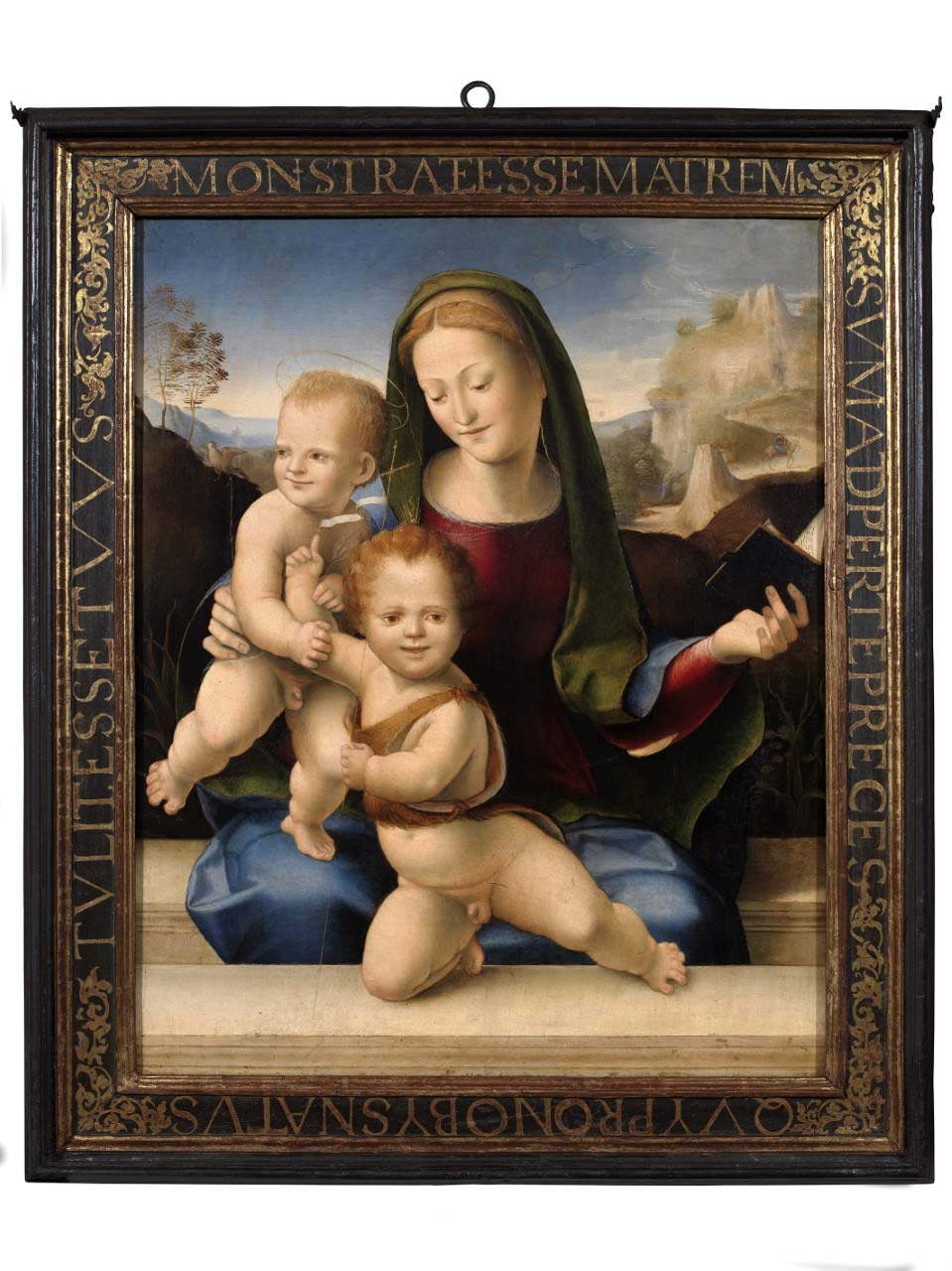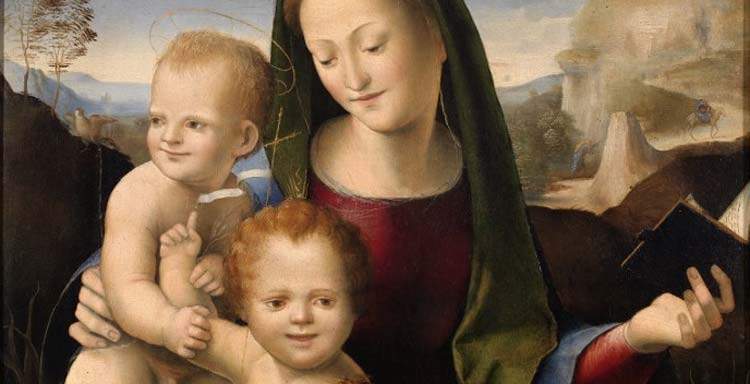A new and important acquisition for the Pinacoteca Nazionale di Siena. In fact, the Tuscan museum’s collection is enriched with a relevant early work by Domenico Beccafumi depicting the Madonna and Child with St. John the Baptist, an oil on panel painting measuring 72 by 58 centimeters, which will be displayed in room 27, the first dedicated to the Sienese painter. The painting will be visible to the public from Feb. 25, and to give a special chance to the citizens, it will be possible to enter the museum, for the day of Saturday only, at a cost of 2 euros.
Beccafumi’s work was bought by its now deceased former owner, Professor Giorgio Giusti, in 1974 as a painting of the “Sienese School of the 1500s.” His family, consisting of six heirs, then proposed its purchase to the state, which accepted. The public recently had a chance to see the work at the exhibition The Good Century of Sienese Painting held at three venues (in Montepulciano, Pienza, and San Quirico d’Orcia) in 2017. Before that, in 1990, it had been at the monographic exhibition on Beccafumi held that year. The purchase, strongly desired by director Axel Hémery, was also made possible thanks to the mediation of Stefano Casciu director of the Regional Museums Directorate of Tuscany, which from 2014 to 2022 managed the Sienese Pinacoteca, which became an autonomous museum in 2022 and seeks all high-level works to augment its collections, which are the most comprehensive on Sienese art, with a special interest in works for sale on the Italian market.

The painting was attributed as early as the 19th century to the famous Sienese painter, but it was in modern times that the first scientific presentation of the painting was made by Fiorella Sricchia Santoro in the catalog of the 1990 Siena exhibition dedicated to the author. After this attribution, and following studies on the young Beccafumi by Alessandro Angelini, it is fair to say that the painting stands as an important piece in the Sienese collection. It is a painting accompanied by an abundant bibliography: the first mentions in the literature date from 1856 and 1865 when Sir Charles Lock Eastlake and then Otto Mündler saw it in the Cisterna collection in Turin, already with an attribution to Domenico Beccafumi. Giovanni Battista Cavalcaselle also commented on the Madonna and Child with St. John in the Passerini collection in Cortona in 1866. The work was later approached with the tondo of the Madonna and Child and St. Giovannino from Berlin and the Chigi Saracini Heroines grouped by Andrea De Marchi in 1988 under the name Maestro delle Eroine Chigi Saracini. Following Fiorella Sricchia Santoro’s intervention in favor of attributing this group of works to Beccafumi, critics are now unanimous in considering the work to be one of the early masterpieces of the Sienese master.
In the work, which is in an excellent state of preservation (which contrasts with the majority of the painter’s panels in the Pinacoteca: a possible explanation lies in the fact that the young artist respected more the precepts of study as a young apprentice than as an independent artist), one finds all the characteristics that mark the young Beccafumi, such as his experiences gained between Siena and Florence before 1510, and is for this reason extremely representative of the beginnings of the career of the great Sienese artist, who reveals himself already informed about the most relevant results of the so-called “modern manner.” In particular, the scene reflects, in the compositional and affective relationship between the three figures, the contacts he had with the painting of Leonardo da Vinci and that of Raphael precisely during the years spent by the Urbino in Florence (1504-1508). And it is precisely to these years, 1508-1510, that the latest studies attribute the dating of the painting, in a path that would lead to a more defined style of the painter, visible in the Triptych of the Trinity of 1513, exhibited in the same room, in which Beccafumi’s accomplished and most characteristic style appears. The painting has in the background a delicate landscape depicting the Holy Family on the Flight into Egypt, showing the artist’s visionary temperament: an anticipation of the magnificent landscape visible in the background of the Stigmata of St. Catherine of Siena between Saints Benedict and Jerome (1514-1515), with which he will engage in dialogue in the same room of the museum.
The painting testifies to the Sienese painter’s interest in the Florentine art of his time, from Fra Bartolomeo to Piero di Cosimo. But Beccafumi is particularly intent on observing Raphael’s Madonnas without neglecting Leonardo’s Madonna dei Fusi, which the position of the San Giovannino seems to echo. Raphael’s 1505 Madonna Terranova (Berlin) seems to have been one of the most important sources for this composition.
The Pinacoteca Nazionale in Siena is the reference museum for Beccafumi’s work. It is the only place where one can follow the entire span of his production from paintings to cartoons. Only the frescoes are missing from this review. The grand altarpieces that testify to the different stages of his artistic journey are present as are the whimsical painted catalets. It is also possible to admire his genius as a draughtsman in the series of Spannocchi cartoons for the floor of Siena Cathedral. Small devotional paintings with the Madonna and Child in the Sienese tradition are not lacking. Lacking, however, was the painting that could show the artist at the dawn of a singular career, to be compared to the works of Sodoma, Pacchia, Pacchiarotti or Genga preserved in the Pinacoteca.
The painting’s long attributive history and the fact that it has always been appreciated by art historians make its entry into a public collection a natural fit. “I am delighted to be able to present the first acquisition of the Pinacoteca Nazionale di Siena as an autonomous institute,” says director Axel Hémery, “and to a particular extent because it is one of its identity artists, Domenico Beccafumi, of whom our museum is the only one that can give a comprehensive view. We are responding to one of our main missions: to increase with targeted and excellent acquisitions the largest collection of Sienese art in the world.”
 |
| Siena's Pinacoteca Nazionale acquires an important work by Domenico Beccafumi |
Warning: the translation into English of the original Italian article was created using automatic tools. We undertake to review all articles, but we do not guarantee the total absence of inaccuracies in the translation due to the program. You can find the original by clicking on the ITA button. If you find any mistake,please contact us.